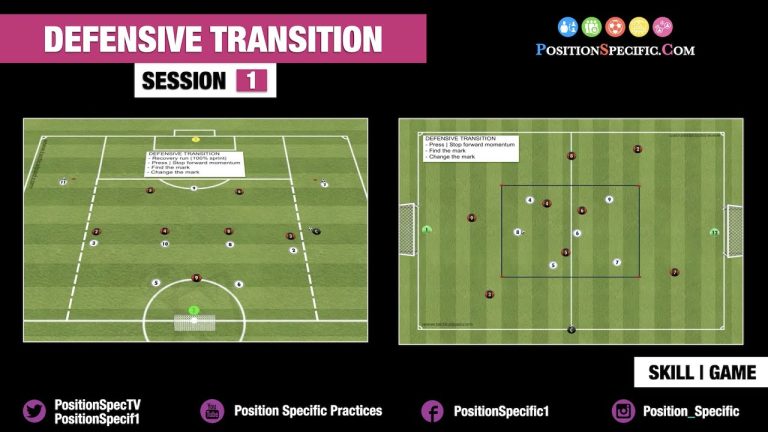Defensive transition in soccer is a crucial aspect of the game that often goes unnoticed. It is the art of quickly and effectively transitioning from attacking to defending, and it can make or break a team’s success on the field. In this article, we delve into the intricacies of defensive transition, exploring the strategies, techniques, and key players involved. From pressing to regrouping, we uncover the secrets behind a solid defensive line and how it can turn the tide of any match. So, get ready to discover the unsung hero of soccer – the defensive transition.
What does defensive transition mean in soccer?
Defensive transition in soccer is the crucial process of regaining control of the ball after losing possession. It is a pivotal moment that demands swift and well-coordinated action from the entire team, as they strive to exploit the opponent’s momentary disarray. This phase requires not only individual discipline but also collective organization to effectively counter the opposition’s potential attacking threats.
During defensive transition in soccer, the team that has just lost possession must swiftly adjust and reposition themselves to regain control. This rapid response is essential to disrupt the opponent’s offensive plans and prevent them from capitalizing on the momentary chaos. Successful defensive transition relies on the team’s ability to act as a cohesive unit, with each player fulfilling their defensive duties and ensuring that gaps in the defense are filled promptly. By effectively executing defensive transition, teams can regain control of the game and neutralize the opponent’s attacking prowess.
How can transitions in football be effectively defended?
In football, defending transitions requires a strategic approach that can be categorized into two main tactics. The first is counter-pressing, where a team aims to swiftly regain possession of the ball as soon as they lose it. This aggressive approach involves immediate pressure on the opposition to disrupt their attacking momentum and potentially create turnovers. On the other hand, some teams opt for a more structured defensive shape during transitions. By quickly regrouping and organizing themselves, they aim to deny the opposition any space or passing options, making it difficult for them to progress towards the goal. Both approaches are essential in managing defensive transitions effectively and preventing the opposing team from gaining an advantage.
What does the transition from attack to defense entail?
The transition from attack to defense is a crucial aspect of the game, requiring swift and seamless coordination. As soon as possession is lost, the defending team must immediately shift their focus to regaining defensive structure. This transition phase is characterized by the team’s rapid adjustment from an attacking mindset to a defensive one, ensuring they can effectively counter any potential threats from the opposition. It is only when the defending team achieves solid defensive organization that the true defensive phase begins, marking the successful completion of the transition.
In the blink of an eye, the dynamics of the game shift as possession changes hands. The transition from attack to defense is a pivotal moment requiring quick thinking and adaptability. Once possession is lost, the defending team must swiftly reorient themselves to protect their goal. This transition phase demands a seamless shift from attacking intent to defensive organization, as the team aims to nullify any potential threats from the opposition. It is only when the defending team achieves a cohesive defensive structure that the true defensive phase commences, signifying the successful completion of the transition.
Mastering Defensive Transitions: Winning Strategies for Soccer Success
Mastering Defensive Transitions: Winning Strategies for Soccer Success
In the game of soccer, defensive transitions play a crucial role in determining a team’s success. By mastering these transitions, teams can effectively shut down their opponents’ attacking plays and create opportunities for counterattacks. The key to a successful defensive transition lies in maintaining a compact and organized defensive shape, swiftly regaining possession of the ball, and quickly transitioning into attack. By implementing strategic pressing and coordinated movements, teams can disrupt their opponents’ build-up play and regain control of the game. Additionally, effective communication and a strong understanding of each player’s role within the defensive system are essential for seamless transitions. With meticulous training and a focus on defensive transitions, teams can elevate their game and achieve soccer success.
Unlocking the Secrets of Soccer’s Defensive Transition: Tactical Insights and Techniques
Unlocking the Secrets of Soccer’s Defensive Transition: Tactical Insights and Techniques
In the fast-paced world of soccer, mastering the art of defensive transition is the key to victory. With every turnover of possession, teams must swiftly shift from attacking to defensive mode, ensuring their opponents are unable to capitalize on the momentary vulnerability. This intricate dance requires a combination of tactical insights and techniques that can turn the tides of the game. From maintaining a well-organized defensive structure to employing effective pressing strategies, teams that excel in defensive transition hold the keys to success on the pitch.
Delving deeper into the realm of defensive transition, teams must focus on honing their communication and anticipation skills. Seamless coordination between players is paramount, as they must read the game and react swiftly as a cohesive unit. Successful defensive transitions rely on players’ ability to anticipate the opposition’s movements and intercept passes, disrupting the flow of play. By mastering these tactical insights and techniques, teams can unlock the secrets of defensive transition and gain a competitive edge that can change the course of the game.
The Winning Edge: Perfecting Defensive Transitions in Soccer
Soccer, known for its fast-paced nature, requires teams to have a strong defensive strategy to maintain control of the game. Defensive transitions play a vital role in soccer as they determine how effectively a team can switch from attacking to defending. By perfecting defensive transitions, teams can gain a winning edge on the field.
The key to mastering defensive transitions lies in quick and coordinated movements. As soon as possession is lost, players must immediately shift their focus from attacking to defending, positioning themselves strategically to regain control of the ball. Communication plays a crucial role in this process, as players must work together to cover gaps and mark opponents. With seamless transitions, teams can effectively disrupt the opponent’s attacking flow, creating opportunities for counter-attacks and defensive stability.
Moreover, fitness and stamina are vital components in perfecting defensive transitions. Soccer is a physically demanding sport that requires players to be agile and quick on their feet. Maintaining a high level of fitness enables players to make rapid movements during transitions, ensuring they are always in the right position to defend. By prioritizing conditioning and endurance training, teams can enhance their defensive capabilities, outperforming opponents and maintaining a solid defensive line throughout the game.
In conclusion, defensive transitions are a crucial aspect of soccer that can make or break a team’s success on the field. By focusing on quick and coordinated movements, effective communication, and maintaining peak fitness levels, teams can perfect their defensive transitions, gaining the winning edge they need to dominate the game. Mastering these defensive strategies will not only provide a solid foundation for a team’s overall performance but also contribute to their success in securing victories.
From Defense to Attack: Proven Tactics for Soccer’s Defensive Transitions
From Defense to Attack: Proven Tactics for Soccer’s Defensive Transitions
Smoothly transitioning from defense to attack is crucial in soccer, and employing proven tactics can make all the difference on the field. Firstly, communication is key. As soon as possession is regained, defenders must quickly relay information to their teammates, directing them towards open spaces and potential passing options. This ensures a swift and coordinated movement towards the opponent’s goal, catching them off guard. Additionally, maintaining a strong defensive shape even during the transition is vital. By keeping a solid structure, defenders can effectively block passing lanes and restrict the opposition’s attacking options, giving their team the upper hand in launching a counterattack.
In soccer, the transition from defense to attack can be a game-changer, and employing effective tactics is essential for success. One such tactic is the quick counterattack. As soon as possession is regained, players must rapidly move the ball forward, catching the opponents off balance and capitalizing on their disorganized defense. This lightning-fast change in momentum can create numerous scoring opportunities and put immense pressure on the opposing team. Furthermore, utilizing overlapping runs can be a potent weapon during defensive transitions. By sending full-backs or wingers on overlapping runs, teams can stretch the opposition’s defense and create gaps for their attacking players to exploit, causing chaos and confusion in the opponent’s backline.
In summary, mastering defensive transition in soccer is crucial for any team aiming to achieve success on the pitch. By seamlessly shifting from attack to defense and maintaining a solid defensive structure, teams can effectively neutralize their opponents’ counterattacks and minimize the risk of conceding goals. With diligent training and a strategic approach, players can hone their defensive skills, contribute to their team’s overall performance, and ultimately increase their chances of victory in the beautiful game of soccer.



